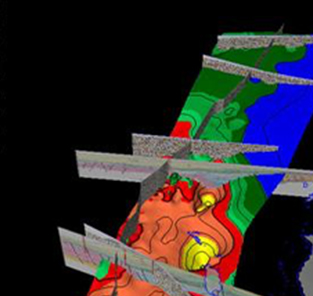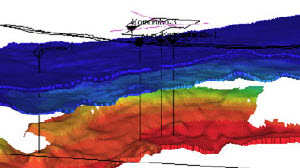The simulator is the core of the PetroMod software suite, enabling simulating the entire history of a sedimentary basin from the deposition of the bottom layer onward. PetroMod software uses consistent simulators in 1D, 2D, and 3D, which means that all technical features and tools are available—and identical—in all dimensions. It also enables using different migration methods—Darcy, flow path (ray tracing), invasion percolation (IP), and PetroMod software’s hybrid Darcy–flow path—IP simulator—with the same data models.
Pressure-temperature modeling
Pressure and temperature simulation is the most fundamental part of PetroMod software’s simulator. Temperature is simulated based on the upper boundary condition determined as the surface temperature, the basal heat flow at the lower boundary of the model, and the thermal conductivity of all layers in the model. Additional effects, such as radiogenic heat generation, can be included. For pressure modeling, various compaction laws can be modeled as defined in the lithologies and pressure boundary conditions can be assigned to account for the effect of regional stress or aquifers.
Petroleum generation
PetroMod software includes a database of reaction kinetics to predict the phases and properties of hydrocarbons generated from source rocks of various types. Adsorption models describe the release of generated hydrocarbons into the free pore space of the source rock. Users can include their own data or select one out of more than 100 default kinetic reactions based on real source rock data from all over the world.
Migration modeling
PetroMod software’s migration modeling technology is the most advanced tool available and the only commercial system with fully PVT-controlled modeling of n-component three-phase relationships during the entire migration process. The 2D and 3D migration modeling technology uses flash calculations throughout the entire model and its geologic history, which improves the understanding and prediction of petroleum properties and oil versus gas probability assessments. Source rock tracking is possible in both 2D and 3D migration modeling for better understanding complex petroleum systems by tracking oil and gas from the source to the trap and evaluating the relative risks of charging from different source units or areas. Migration simulation methods include Darcy flow, flow path analysis, hybrid petroleum migration modeling technology, and invasion percolation.



